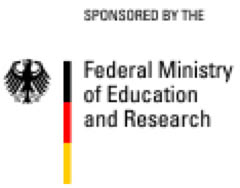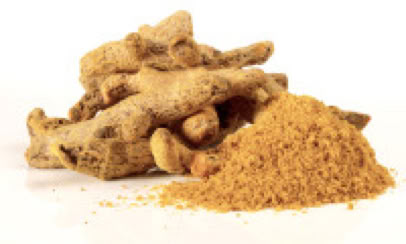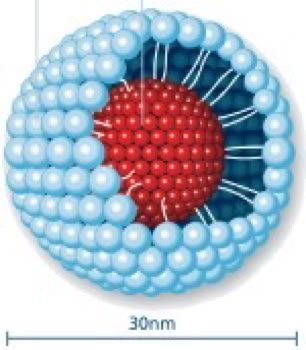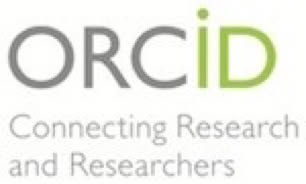
BMBF-sponsored research on curcumin
Novel strategies for the enhancement of the potency of nutraceuticals with low oral bioavailability and their application in novel functional foods for optimum protection of the aging brain
A research network sponsored by the German Federal Ministry of Education and Research
Curcumin is a nutraceutical intensively investigated for its potential use as a therapeutic or preventive agent against a number of degenerative diseases, including cancer and Alzheimer's disease. Curcumin is the coloring agent derived from the root of the plant Curcuma longa and gives the yellow color to the spice curry, in which it is found in significant amounts. It is also commonly used, under the designation "E 100", as a coloring agent by the food industry.
Because of its potent health beneficial activities, such as antiinflammatory, antioxidant, and anticancer effects, to name only a few, researchers have attempted to enhance the uptake and retention of the phytochemical in the body. Curcumin, however, remains a very difficult compound to detect in the body, because it is taken up into the body to a limited extent and subsequently rapidly metabolised and excreted from the organism. Hence, an important question in this context remains largely unanswered: Could the health beneficial activities of curcumin be enhanced if more of the active compound would reach the site of action, e.g. the brain
To answer this and a number of related questions, Dr. Frank (University of Hohenheim) coordinated a research network consisting of five academic and five industry partners, which was financially supported by the German Federal Ministry of Education and Research with ca. € 1.5 M.
In the project, novel strategies to enhance the bioavailability and retention of curcumin in the organism were developed and researched for their impact on the pharmacokinetics, biological activities, and the safety of the nutraceutical. The novel micellar curcumin-formulations developed within this project were then tested for their biological activities and suitability as ingredients in a range of different functional foods.
The work packages of this research network were lead by Prof. Dr. Frank from the Institute of Biological Chemistry and Nutrition at Hohenheim University, PD Dr. Gunter Eckert from the Department of Pharmacology at the Johann-Wolfgang-Goethe University, Dr. Jakob Weissenberger from the Department of Neurosurgery at the University Hospital of theJohann-Wolfgang-Goethe University (Frankfurt/Main), Prof. Dr. Gerald Rimbach from the Institute of Human Nutrition and Food Science at Christian-Albrechts-University in Kiel, Prof. Dr. Tilman Grune from the Institute of Human Nutrition at the Friedrich-Schiller-University in Jena, Dariush Behnam, CEO of Aquanova AG, Dr. Josef Jandasek, Senior product developer at Raps GmbH & Co KG, Kalle Debus, Product Manager at Hassia Mineralquellen, Dr. Carola Funk, General Manager R&D at Kampffmeyer Food Innovation, and Julius Semrau of Schwartauer Werke.



Scientific papers related to this project
Flory, S., Männle, R. & Frank, J. (2021) The inhibitory activity of curcumin on P-glycoprotein and its uptakeby and efflux from LS180 cells is not affected by its galenic formulation. Antioxidants10: 1826, IF 6.312.
Flory, S., Sus, N., Haas, K., Jehle, S., Kienhöfer, E., Wähler, R., Adler, G., Venturelli, S. & Frank, J. (2021) Increasing post-digestive solubility of curcumin is the most successful strategy to improve its oral bioavailability: a randomized cross-over trial in healthy adults and in vitro bioaccessibility experiments. Mol Nutr Food Res 65: 2100613, IF 5.914.
Seiwert, N., Fahrer, J., Nagel, G., Frank, J., Behnam, D. & Kaina, B. (2021) Curcumin administered as micellar solution suppresses intestinal inflammation and colorectal carcinogenesis. Nutrition and Cancer 73: 686-693, IF 2.900.
Khayyal, M. T., El-Hazek, R. M., El-Sabbagh, W. A., Frank, J., Behnam, D. & Abdel-Tawab, M. (2018) Micellar solubilisation enhances the anti-inflammatory activities of curcumin and boswellic acids in rats with adjuvant-induced arthritis. Nutrition 54: 189-196, IF 3.420.
Frank, J., Schiborr, C., Kocher, A., Meins, J., Behnam, D., Schubert-Zsilavecz, M. & Abdel-Tawab, M. (2017) Transepithelial transport of curcumin in Caco-2 cells is significantly enhanced by micellar solubilisation. Plant Foods for Human Nutrition 72: 48-53, IF 2.276.
Dützmann, S., Schiborr, C., Kocher, A., Pilatus, U., Hattingen, E., Weissenberger, J., Gessler, F., Quick-Weller, J., Franz, K., Seifert, V., Frank, J. & Senft, C. (2016) Intratumoral concentrations and effects of orally administered micellar curcuminoids in glioblastoma patients. Nutr Cancer 68: 943-948, IF 2.322.
Kocher, A., Bohnert, L., Schiborr, C. & Frank, J. (2016) Highly bioavailable micellar curcuminoids accumulate in blood, are safe and do not reduce blood lipids and inflammation markers in moderately hyperlipidaemic individuals. Mol Nutr Food Res 60: 1555-1563, IF 4.551.
Bortel, N., Armeanu-Ebinger, S., Schmid, E., Kirchner, B., Frank, J., Kocher, A., Schiborr, C., Warmann, S.W., Fuchs, J. & Ellerkamp, V. (2015) Effects of curcumin in pediatric epithelial liver tumors: inhibition of tumor growth and alpha-fetoprotein in vitro and in vivo involving the NFkappaB and the beta-catenin pathways. Oncotarget, 6: 40680–40691, IF 6.359.
Hagl, S., Kocher, A., Schiborr, C., Kolesova, N., Frank, J., & Eckert, G. P. (2015) Curcumin micelles improve mitochondrial function in neuronal PC12 cells and brains of NMRI mice - Impact on bioavailability. Neurochemistry International 89: 234-242, IF 3.092.
Kocher, A., Hagl, S., Schiborr, C., Eckert, G. P., & Frank, J. (2015) Concentrations of total curcuminoids in plasma, but not liver and kidney, are higher in 18- than in 3-months old mice. NFS Journal1: 3-8.
Kocher, A., Schiborr, C., Behnam, D., & Frank, J. (2015) The oral bioavailability of curcuminoids in healthy humans is markedly enhanced by micellar solubilisation but not further improved by simultaneous ingestion of sesamin, ferulic acid, naringenin and xanthohumol. J Funct Foods 14: 183-191,IF 4.480.
Hagl, S., Heinrich, M., Kocher, A., Schiborr, C., Frank, J. & Eckert, G. P. (2014) Curcumin micelles improve mitochondrial function in a mouse model of Alzheimer's disease. The Journal of Prevention of Alzheimer’s Disease 1: 80-83.
Chin, D., Hagl, S., Höhn, A., Huebbe, P., Pallauf, K., Grune, T., Frank, J., Eckert, G.P. & Rimbach, G. (2014) Adenosine triphosphate concentrations are higher in the brain of APOE3 compared to APOE4 targeted-replacement mice and can be modulated by curcumin. Genes & Nutrition9: 397,IF 3.329.
Chin, D., Huebbe, P., Frank, J., Rimbach, G., & Pallauf, K. (2014) Curcumin may impair iron status when fed to mice for six months. Redox Biology2: 563-569.
Schiborr, C., Kocher, A., Behnam, D., Jandasek, J., Toelstede, S. & Frank, J.(2014) The oral bioavailability of curcumin from micronized powder and liquid micelles is significantly increased in healthy humans and differs between sexes. Mol Nutr Food Res 58: 516-527, IF 4.909.
Schiborr, C., Schwamm, D., Kocher, A., Rimbach, G., Eckert, G. P., & Frank J (2013) The senescence-accelerated mouse - prone 8 is not a suitable model for the investigation of cardiac inflammation and oxidative stress and their modulation by dietary phytochemicals. Pharmacol Res 74: 113-120, IF 4.436
Eckert, G. P., Schiborr, C., Hagl, S., Abdel-Kader, R., Müller, W. E., Rimbach, G., & Frank, J. (2013) Curcumin prevents mitochondrial dysfunction in the brain of the senescence-accelerated mouse - prone 8. Neurochemistry International65: 595-602, IF 2.857.
Schrader, C., Schiborr, C., Frank, J. & Rimbach, G. (2011) Curcumin induces paraoxonase-1 in cultured hepatocytes in vitro but not in mouse liver in vivo. Brit J Nutr 105: 167-170, IF 3.072.
Schiborr, C., Eckert, G. P., Weissenberger, J., Müller, W. E., Schwamm, D., Grune, T., Rimbach, G. & Frank, J. (2010) Cardiac oxidative stress and inflammation are similar in SAMP8 and SAMR1 mice and unaltered by curcumin and Ginkgo biloba extract intake. Curr Pharmaceut Biotechnol 11: 861-867, IF 3.455.
Schiborr, C., Eckert, G. P., Rimbach, G. & Frank, J. (2010) A validated method for the quantification of curcumin in plasma and brain tissue by fast narrow-bore high-performance liquid chromatography with fluorescence detection. Anal Bioanal Chem 397: 1917-25, IF 3.841.
Home | Staff | Publications | Laboratory |Grants| Curcumin| For students | Jobs | Contact | Privacy Policy




